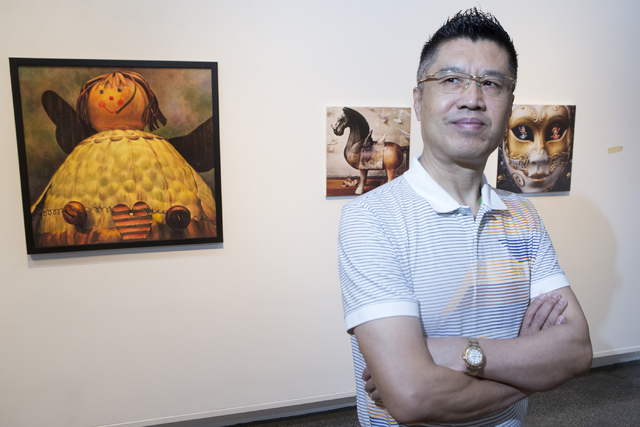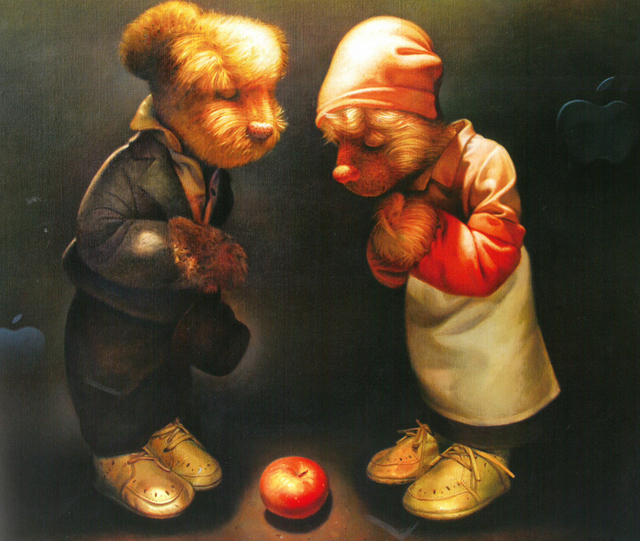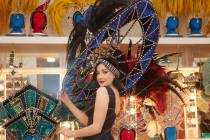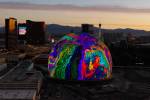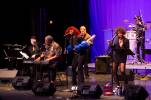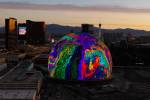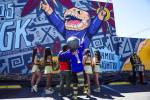Library exhibit showcases Chinese artist’s fascination with Las Vegas
In his native China, artist Cheng Yajie learned to paint what he saw.
In Vienna, he learned to paint what he saw in his imagination.
And in Las Vegas, he found new inspiration for that imagination.
Cheng’s Vegas visions — and other examples of his award-winning work — begin an extended Southern Nevada stay with the exhibit “A Las Vegas Symphony,” which continues through Oct. 1 at the Sahara West Library’s Studio gallery.
But the Sahara West exhibit is only the first step in a journey that will bring Cheng’s work to 13 Las Vegas-Clark County Library District branches. (The exhibit’s second stop: the Whitney Library, starting Nov. 10.)
The library district’s invitation-only galleries generally showcase Southern Nevada artists, according to Darren Johnson, gallery services coordinator.
“It can be kind of complicated bringing in art,” he explains. “For the most part, the reason is cost.”
But when Cheng himself contacted the library district and “generously offered” to ship his artworks to Las Vegas, Johnson notes, it was an offer they couldn’t (and didn’t) refuse, “once I saw his art.”
For Cheng, 58, discovering that Las Vegas’ libraries had art galleries made them “the most suitable place” to display his works, the artist says in an interview at the Sahara West gallery. (Cheng’s daughter Natalie, 28, served as interpreter, translating her father’s comments from Mandarin to English.)
Because libraries are “close to the heart of many people, not just the exclusive group who go to galleries,” the library galleries make “art accessible to all,” in the artist’s view.
This artist’s view encompasses a wide world of subjects, and styles, from photo-like realism to vibrant abstract expressionism to fanciful surrealism, culminating in what he dubs “The Vegas Style.”
Cheng’s “Vegas Style” represents “a fusion of ideas,” he explains, employing disparate elements that reflect “the magic part of Vegas,” from numbers to the hearts, clubs, spades and diamonds seen on decks of cards.
In “A Faraway Friend Springtime in the Desert,” a tourist rides a camel, the latter symbolizing the desert. And though surrounding butterflies — a recurring motif in Cheng’s work — “don’t appear in the desert,” he notes, they represent “the dreams of people. People bring butterflies, their dreams, and they create Vegas in the desert.”
Another “Vegas Style” work, “Return to Las Vegas — Spring,” depicts the wedding of a teddy-bear couple, surrounded by butterflies, numbers, hearts and dollar signs, suggesting the various reasons (love and/or money) people (and teddy bears) gravitate to Las Vegas.
As Natalie Cheng translates for her father, “there’s a lot of joy here,” she says. “He feels that Vegas is a place of happiness.”
It’s also a place of creativity.
Cheng began “Return to Vegas — Spring” during a previous visit to Southern Nevada, when he was so inspired by the surroundings that he bought an easel and paints at a local art supply store so he could start the watercolor, which he finished back home in Singapore.
The “psychedelic colors” of another, more abstract painting capture “a splash of vibrancy,” suggesting the neon lights of the Strip, Cheng notes. “In Vegas, the later it gets, the more beautiful it becomes.”
The road to Cheng’s “Vegas Style” began in his native Beijing, when he began painting at age 4. A few years later, his parents “had engaged a professional” to tutor him.
The son of a photographer and videographer, Cheng learned the social realism taught in China — or, as the artist phrases it, “just painting things that you see,” with artists striving to “mimic photography.”
He smiles sardonically, remembering.
“In China, there’s a sea of artists,” he says, describing them as “very hardworking, but everything looks the same. They’re just painting what they see. Every artist’s work looks like every other artist’s work.”
Additional study in Japan and the then-Soviet Union followed his 1985 graduation from China’s Tianjin Academy of Fine Arts.
The next step in his artistic journey took him to Austria, when his work attracted the attention of artist Wolfgang Hutter, who invited Cheng to participate in his master classes at the Vienna Academy of Arts.
There, Cheng learned Hutter’s specialty, fantastic realism, earning a master’s degree and becoming a finalist in Europe’s 1994 SHEBA competition with his painting “My Precious.”
Hutter taught Cheng a vital lesson, “to use your creativity to create a world for people to see,” he explains, “and not just replicate what you see in real life.”
That in turn led to a 1995 invitation from Singapore’s then-governor, Lee Kuan Yew, who commissioned Cheng to paint a series of oil portraits — and a second invitation to make Singapore his home.
About a decade ago, an exhibit led Cheng to New York — and the “really open” U.S. art scene. “The U.S., given its politics and history, was more liberating,” he observes, with Las Vegas being at “the forefront” of that artistic freedom.
But perhaps Cheng’s fascination with Las Vegas was always in the cards.
After all, “the first painting he ever sold,” in Vienna, Natalie Cheng notes, “was to a casino owner.”
Read more from Carol Cling at reviewjournal.com. Contact her at ccling@reviewjournal.com and follow @CarolSCling on Twitter.
Preview
What: Cheng Yajie's "A Las Vegas Symphony of Art"
When: 10 a.m.-7:45 p.m. Mondays through Thursdays, 10 a.m.-5:45 p.m. Fridays through Sundays, through Oct. 1
Where: Sahara West Library Studio gallery
Admission: Free (702-507-6222)



